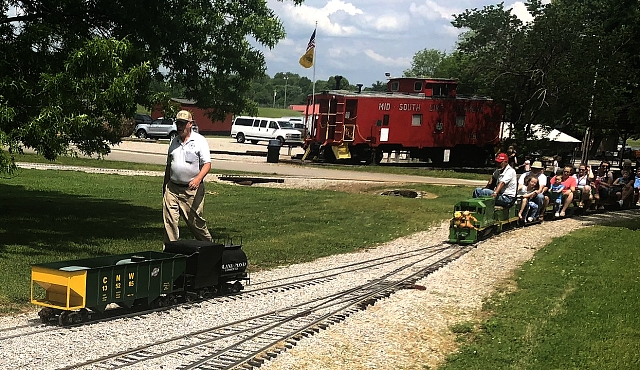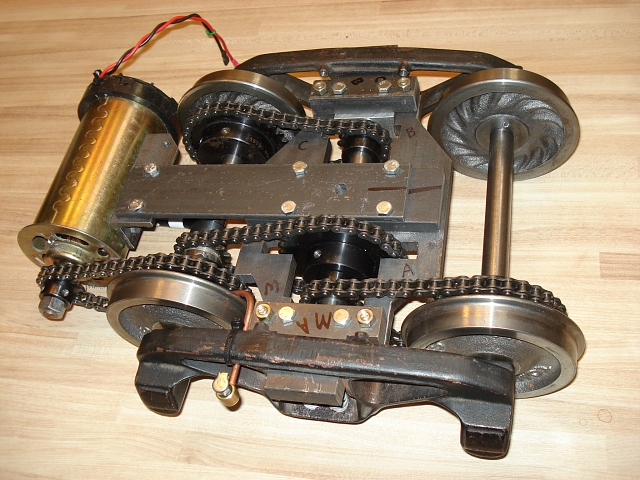Building a Powered Tender Truck
(MSLS Summer 2019 Newsletter)
-

(select photo for larger image)
Here is the powered electric tender pushing a hopper car ahead of one of the club trains.
I had to jump off and throw a switch to clear the main line for the passenger train
behind me. After returning the switch, I had to run to catch up with my own train
which was still moving.
Why would I want to power my tender?
Three answers persist.
1. To power a fake or "dummy" steam engine.
2. To power a true live steamer without firing it.
3. To use as a booster with an operating live steam locomotive.
First, there are increasing numbers of hobbyists that want an "electric" steam
locomotive. I know of at least two suppliers of these. Plus, there is plenty of
opportunity here for those who still want to build their own.
Second, there are times I want to run my 2-8-2 but don't want to or can't fire it,
for example, when I have visitors show up unexpectedly.
My Mikado never had a working live steam boiler, only a fake one, even though the
locomotive itself was capable. For years I ran it on a compressor in a boxcar hidden
somewhere in the consist.
Third, I have been asked by many if it can be used as a booster with an operating
live steam engine, and of course, it can. Some surviving full-size locomotives have
tenders with booster trucks (like SP 4449). Some even still work.
It can be used as a booster for those who have trouble on the hills or want to run
longer trains.
It can also be used as a switch engine or just to move cars. It is an ideal tractor.
-

Powered Tom Bee "Bettendorf" Truck
(select photo for larger image)
Some builders of electric steam engines put the electric motor(s) in the locomotive.
This is kind of a bad idea, since the locomotive doesn't weigh much and won't have
much traction.
One builder boasts of how many cars his engine can pull, but he's on the flatlands.
Putting the electric motor in the tender is better
because the weight of the batteries and engineer are there and
both (usually)
have considerable weight.
Note: The motor can be positioned either behind the truck (as shown) or directly
above it - inside the tender carbody.
Building the Powered Truck
I started with a standard "Tom Bee" Bettendorf freight car truck. I then removed the
original bolster and wheelsets.
This modification requires 4 chains and 8 sprockets. All chains are #35 and are of
the same length, namely 46 links. This motor
is a 2.5 HP permanent magnet 130 volt DC treadmill motor. But the truck can be
powered using other types of motors as well.
The motor drives a reduction idler (running on one of the axles).
You can see the oil cup to supply oil to the idler bushings.
The idler drives an output shaft in the center which drives both axles identically.
The output shaft uses the same size and type of needle bearings as the axles.
Here is a breakdown and description of the chains and their associated drive and load
sprocket tooth counts as well as the resulting ratios.
Drive Load
Chain Teeth Teeth Ratio Reduction
--------------- ----- ----- -------- --------------
Motor to Idler 11 30 .3666667 (2.727273 : 1)
Idler to Output 13 30 .4333333 (2.307692 : 1)
Output to Axle (2) 13 30 .4333333 (2.307692 : 1)
------
Net ratio .06885185 (14.52394 : 1)
|
Feel free to go out and build your own!
Bill
More details here
|